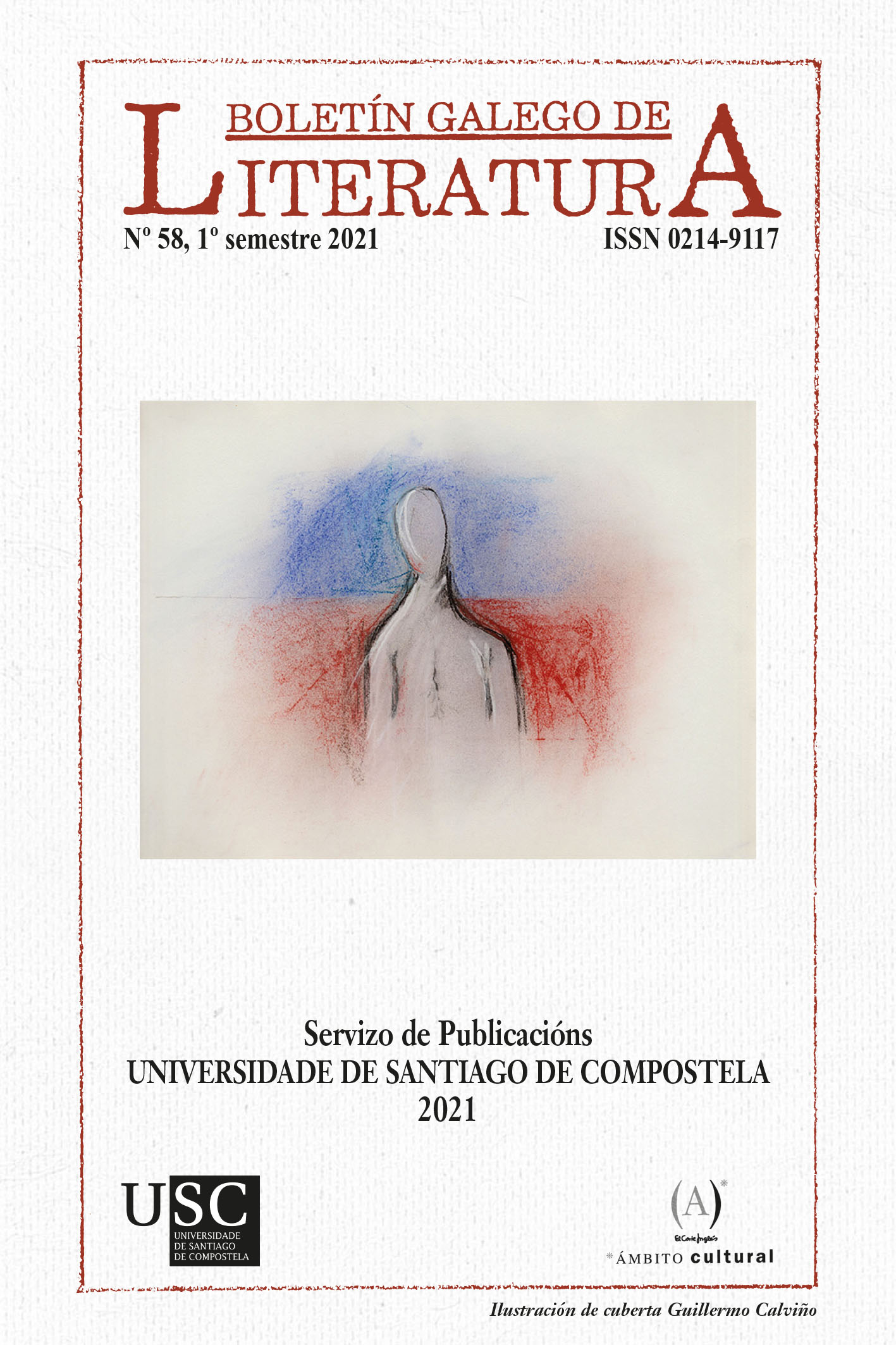The materiality of the book on the creation of figured spaces in El gran hotel Wes Anderson, by Nuria Díaz
Main Article Content
Abstract
El gran hotel Wes Anderson (2018) is an informative book by the Galician illustrator Nuria Díaz that experiments with materiality through the creation of figurative spaces that play with the reader's role as a hotel guest, whose rooms can be visited page by page. Through them, the reader will learn about the life and work of the filmmaker Wes Anderson, as well as the most characteristic aspects of his professional work, by means of clear and aesthetically very careful information, giving special prominence to the visual component. The aim of this work is to analyse the way in which the proposal takes shape through the textual and compositional analysis of the book, paying special attention to its nature as a book-object and to the function of the paratexts, to conclude by reflecting on how its form and content bring it closer to or distance it from adults or young audiences.
Keywords:
Article Details
References
Carter, B. (2001) Libros de información: del placer de saber al placer de leer. Banco del Libro de Caracas.
Díaz, N. (2019). El Gran Hotel Wes Anderson. Lunwerg.
Equipo GLIFO (s.d.). Dicionario de Termos Literarios (DiTerLi). Santiago de Compostela: Xunta de Galicia e Centro Ramón Piñeiro para a Investigación en Humanidades. http://bernal.cirp.gal/ords/f?p=106:50
Garralón, A. (2013). Leer y Saber, los libros informativos para niños. Tarambana.
Lugo Rodríguez, N. (13-14 de maio de 2010). Fanart y fanfiction, una estrategia de aprendizaje para los nativos digitales y sus profesores [Comunicación]. Congreso Euro-Iberoamericano de Alfabetización Mediática y Culturas Digitales, Sevilla. https://idus.us.es/xmlui/handle/11441/56148
Mangarelli, M. (2020). Biografías para niños: Estrategias narrativas y pictóricas. Cuadernos de Literatura Infantil y Juvenil, 296, 34-45.
Mociño González, I. (2019). Libro-Obxecto e Xénero: Estudos ao redor do libro infantil como artefacto. Servizo de Publicacións da Universidade de Vigo. http://www.investigo.biblioteca.uvigo.es/xmlui/handle/11093/1631
Ramos, A. M. (2017). Aproximações ao livro-objeto: das potencialidades criativas às propostas de leitura. Tropelias & Companhia.
Ramos, A-M. y Navas, D. (2015). Narrativas juvenis: o fenómeno crossover nas literaturas portuguesa e brasileira. Elos. Revista de Literatura Infantil e Xuvenil, 2, 233-256. http://dx.doi.org/10.15304/elos.2.2745
Rosenblatt, L. (2002) La literatura como exploración. Fondo de Cultura Económica de México.
Sampériz, M., Tabernero, R., Colón, M. J., e Manrique, N. (2021). El libro de no ficción para prelectores. Análisis de las claves de construcción del discurso. Cuadernos Del Centro De Estudios De Diseño Y Comunicación, 124, 73-90. https://doi.org/10.18682/cdc.vi124.4418
Shavit, Z. (1986). Poetics of Children's Literature. The University of Georgia Press.
Silva, S. R. da (2020). Clássicos da Literatura infantojuvenil em forma(to) de livro-objeto. UMinho Editora.
Silva, S. R. da (2020). Livros que são casas ou quando ler também é brincar. En C. Sousa Pereira (Org.), Literatura infantojuvenil: Livro-Objeto e patrimóni(os) (pp. 181-195). Tropelias&Companhia.
Sousa Pereira, C. (2020). Literatura infantojuvenil: Livro-Objeto e patrimóni(os). Tropelias & Companhia.
Tabernero Sala, R. (2017). O leitor no espaço do livro infantil. Para uma poética da leitura a partir da materialidade. En A. M. Ramos (Org.), Aproximações ao livro-objeto: Das potencialidades creativas às propostas de leitura (pp. 181-199). Tropelias&Companhia.
Tabernero Sala, R. (2019). El objeto libro en el universo infantil: la materialidad en la construcción del discurso. Prensas de la Universidad de Zaragoza.
Most read articles by the same author(s)
- Rocío G-Pedreira, Theatre, Childhood and School: reflections about the dramatic genre in Children's Literature , Elos: Revista de Literatura Infantil e Xuvenil: No 4 (2017)
- Rocío G-Pedreira, Olalla Cortizas Varela, Stopmotion' film adaptations of Roald Dahl's 'James and the Giant Peach' and 'Fantastic Mr. Fox' , Elos: Revista de Literatura Infantil e Xuvenil: No 5 (2018)
- Rocío G-Pedreira, Children’s Fantasy Literature. An Introduction , Elos: Revista de Literatura Infantil e Xuvenil: No 5 (2018)
- Rocío G-Pedreira, Guerras mundiais na Literatura Infantil e Xuvenil galega. Roles femininos. , Boletín Galego de Literatura: No 52 (2018): 1º semestre
- Rocío G-Pedreira, Proposal of an emotional intelligence model applied to the reading experience in scholar contexts , Innovación educativa: No 28 (2018): In the centenary of the Institute-School creation: past, present and future of the integrated public schools of compulsory primary and secondary education
- Rocío G-Pedreira, The complexity of Cada corazón, un umbral’s fantasy model , Boletín Galego de Literatura: No 54 (2019): 1º semestre
- Rocío G-Pedreira, ...de ninfas, hadas, gnomos y otros seres fantásticos. Un viaje por los personajes que alimentan la fantasía en todos los tiempos , Boletín Galego de Literatura: No 55 (2019): 2º semestre
- Rocío G-Pedreira, Sexual experience with the monster in modern fairy tale The Shape of Water carried out by Guillermo del Toro , Boletín Galego de Literatura: No 55 (2019): 2º semestre
- Rocío G-Pedreira, A incidencia de reescrituras fílmicas na relación de nomeados e premiados dos principais galardóns internacionais a longametraxes animadas , Boletín Galego de Literatura: No 56 (2020): 1st semester
- Rocío G-Pedreira, Comparative analysis between literature and comic: Los que quedan (2019) by Josep Busquet and Alex Xöul , Boletín Galego de Literatura: No 57 (2020): 2nd semester







